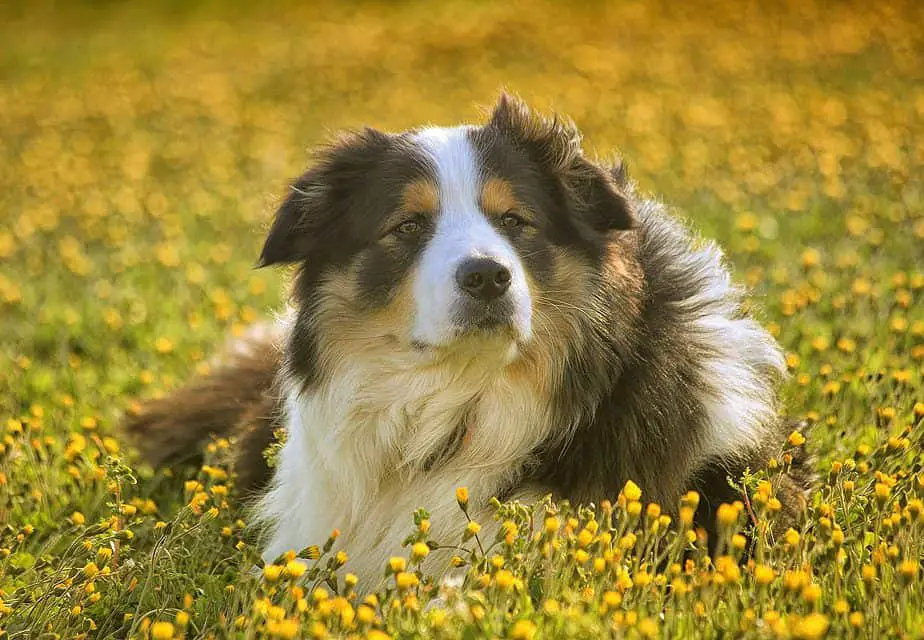
Crouching or some version of it, such as lowering the head to the ground, is common for dogs, especially herding and working breeds. You may wonder why your pet drops to the ground when seeing you or encountering a dog outside.
Dogs drop to the ground – or crouch low – to communicate various emotions. A dog may lower the torso or head out of vigilance when he or she spots another animal. Crouching can also communicate fear or stress. If your pet crouches when seeing you, the behavior likely expresses playfulness.
Some breeds are more prone to this peculiar behavior, but all dogs tend to have specific triggers.
WHY DOGS CROUCH/DROP TO THE GROUND
Herding Or Working Breed Background
Although dogs of any breed can have the habit of lowering themselves to the ground in certain situations, being a herding breed dog is a major factor.
If you are a lucky pet parent of a corgi, Sheltie, border collie, or Aussie, your dog is probably quick to crouch low in response to various stimuli. As farm dogs, these pups crouched to watch livestock and predators and sometimes had to approach other animals or other objects while keeping low to avoid being noticed.
Dogs of the working group, such as Bernese mountain dogs, are also quick to drop to the ground, especially in a state of heightened alertness.
Herding and working dogs have strong instincts, so their skills and behaviors persist over generations.
COMMON TRIGGERS OF CROUCHING
Vigilance And Caution
Regardless of the breed, dogs communicate specific emotions and states through their behaviors.
If your pet is uncertain how to behave in a given situation, he or she may crouch down and watch. For example, the dog may react this way to an unfamiliar dog. Your pet is not necessarily afraid or aggressive but prefers to stay low and not engage with the other animal.
The problem with this behavior around other people or animals is that a stranger could interpret crouching as a sign of aggression.
Stress or Fear
Dogs can express discomfort around other animals or people by dropping to the ground and watching. Often they growl or whine at the same time.
Fear and aggression can sometimes go hand-in-hand in animals, so it is important to observe your furry friend. If you are outside, command your pet to stay near and keep him or her on a close leash for safety.
Excitement And Playfulness
You may see dogs lowering themselves to the ground when playing, and in this situation, the crouching is a sign of ultimate excitement and playfulness.
One of our rescue dogs, likely at least half border collie based on her appearance, never learned to play with toys but she did learn to hop and run erratically she is feeling silly with excitement! We know that she feels playful when she begins to crouch low and gets that sparkle in her eyes.
Dropping to the ground or even just lowering the head is a common way to communicate a bubbly happy mood. If your dog acts this way when seeing you, your pet likely feels happy. The crouching is an invitation to play.
Should I Train My Dog to Stop Crouching?
Crouching is common for many animals. There is no need to discourage the behavior unless it causes issues socially, specifically if it is often mistaken for a sign of aggression by other dogs and dog owners.
If crouching worries you, it also could be because you notice behavioral problems with your pup. Then you would need to address your pet’s behavior overall.
There are steps to discourage crouching in specific situations.
Distraction, Or Shifting The Focus
This method works very well with border collies and other herders in particular. Your dog needs to respond to commands well.
- Observe and note the triggers for crouching or excessive excitement in your pet.
- Meeting an unfamiliar dog on a trail is a common trigger, for example, and it is a situation that could lead to an incident if the other dog misinterprets your pet’s behavior as aggressive.
- When you see another dog approaching, proactively ask your pet to focus on something else – on your face or a toy. You could simply call your dog’s name to get his or her attention.
- Alternatively, ask the dog to sit.
- Most dogs of herding breeds easily shift their focus and ignore an approaching dog or a human passer-by, after a few practice times.
Train When The Dog Can Focus
Changing behavior requires training – it is just like learning a new skill.
Choosing the right time for training is important for any dog.
- Please choose a time when it is quiet and there is not much activity around when you train your dog.
- It is important to start training in a familiar environment and later practice outside or in complex situations.
- Keep the training sessions brief, about 10-15 minutes.
- If your dog is not focusing well, pause and try another time.
Be Consistent
- If you choose a command to address behavior, be methodical at using it, at least in the beginning while your dog is still learning. Use the command every time you want your dog to stop and reward if your pet listens.
- If your dog is not very obedient yet or does not always pay attention to commands, especially outside, use your pet’s name every time with the command and reward good behavior.
- Use treats in the beginning but eventually, verbal praise or neck rubs are just as effective.
Address Behavioral Issues and Triggers Overall
It is well known that some general guidelines help reduce any problem behaviors, including crouching, if it becomes an issue. Those general recommendations address the underlying causes, such as anxiety or boredom.
The idea is to provide opportunities to stay active, which is especially important for herders and working breeds. Your dog should have toys, puzzles, and other ways to engage his or her busy mind.
Having other pets in the household often effectively prevents boredom and behavioral problems. And, of course, dogs need some regular interactions with the owner and other household members.
Again, those guidelines do not address the crouching behavior per se but improve the dog’s well-being and behavior in general, which can reduce crouching if it is due to stress.
Related Questions:
How To Stop My Dog From Herding Cats?
Teaching your dog to stop chasing and herding could be challenging because the behavior is instinctive, especially with herding breeds. Thankfully, most herders respond to training and love pleasing the owner. Providing opportunities to run and exercise and allowing your pet to socialize with other animals and people helps curb the herding instinct. The ava
Recent Posts
Owners of corgis sometimes hesitate to involve their pets in intense exercise due to these dogs’ physiques. However, corgis are athletic dogs and there are several great options for activities and...

